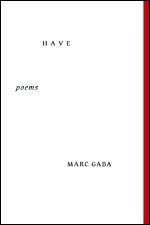Unfolding Have
 Have
Have
by Marc Gaba
Tupelo Press, 2011
72 pages / $16.95 Buy from Amazon or Tupelo Press
“I wanted the head, as it were, to be more like another limb,” says Lucian Freud, and by doing so shifts expression from the face to the entirety of the body. “I wanted the head, as it were, to be more like another limb,” so by epigraph begins Marc Gaba’s Have. We can begin a reading with this quote from Freud, and in doing so offer a reading that does not evaluate, but shifts the expression, in a way that a book becomes among many possible books, each one possible through the subjectivity that expresses it. But in the hope that what we have is not mere reader response, which as a false utopia can mean that given many-ness, then everything is valid. As Jean-Luc Godard says, “This is not a just image, this is just an image,” distilling the many meanings of “just” connoting validity (reasonable, proper, exact, precise) into “simply,” that is, one among many. It is to acknowledge not many “valid” things, but many-ness itself, the Deleuzian multiplicity.
My practice,” Gaba writes in his exhibition notes to Where or When “is a continual exploration of how the relation between the virtual and the actual might be configured and rendered.” How apt then to study lines and colors, when after Manuel de Landa (a redoubtable reader of Deleuze) we take the actual as “extended and differentiated in space and time,” and the virtual as “intensive and formless.” We find in Gaba “threads for whom color stashed from/all innocence” after material and experiential lines and pieces of color such as “betrayal white,” “subtitle white”, “glass black.” Sarah Gridley, in the book’s blurb, writes of Gaba’s attention to the line, and notes that in Gaba “lineation is both a form and a subject,” and of “the physical-metaphysical ‘fold’ [as] conjured through a painstaking attention to line as ultimate paradox: that which joins in the very act of dividing.”But a line, Deleuze writes, more than this binary opposition of joining and dividing, is also “a line [that] does not [only] go from one point to another, but passes between the points, ceaselessly bifurcating and diverging.” Lines of flight which flow and leak, moving from the actual to the virtual:
In Exodus Diptych (shown here as one spread, printed in the book as verso and recto pages, pp. 16 – 17), the ‘narrative’ line moves from the ‘land of passage’ to the ‘eyed world ‘ from the verso page to the recto page, from the dimension of the TV to the ‘actual’ dimension, from the story of Moses to a comedy show. One plane of sensibility leaking unto the next; “Believe” folded with “Be loved,” the pleating made visible by the vertical bar (“|”) deterritorialized from the areas of logic and typography, and reterritorialized into the area of prosody: In Deleuze’s reading of Leibniz and Foucault, Simon Sullivan notes of the fold, in his entry in the “The Deleuzian Dictionary,” as that which names the relationship of oneself to one self. In Leibniz, “subjectivity is a question of mastery – a kind of Nietzschean mastery – over the swarm of one’s being […] To ‘have’ is to fold that which is outside inside” READ MORE >January 3rd, 2014 / 11:00 am


![[Exodus Diptych]](http://htmlgiant.com/wp-content/uploads/2013/12/Unfolding-Have02-500x157.jpg)
![[from To Have Witnessed]](http://htmlgiant.com/wp-content/uploads/2013/12/Unfolding-Have03.jpg)